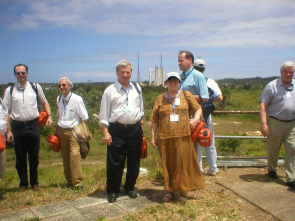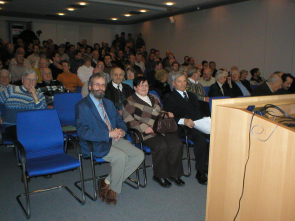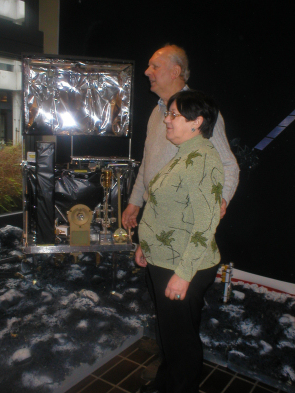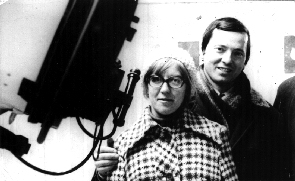Svetlana Gerasimenko - co-discoverer of comet 67P
In August 2014, after a 10-year space trek, the Rosetta spacecraft closed in on its target: a periodic comet named 67P/Churyumov-Gerasimenko, after its two co-discoverers.
Among the legions of scientists who are following the historic exploits of Rosetta and its small Philae lander is Svetlana Gerasimenko, one of the researchers who, along wth Klim Churyumov, discovered the comet 45 years ago.
 |
| Svetlana and Klim Churyumov in Kourou, with the Ariane rocket which launched Rosetta in the background. Image courtesy of Svetlana Gerasimenko |
Svetlana was born in the Ukrainian village of Baryshevka (near Kiev) on 23 February 1945. While at school she developed an interest in astronomy. This coincided with the period when active space exploration began and, as was the case for many teenagers, Svetlana dreamed about becoming a cosmonaut or studying objects in space. In her case, the dream came true.
In 1963, she enrolled as a student at Kiev University, studying astronomy in the physics faculty. Five years later, she entered the postgraduate training programme led by Professor Sergej K. Vsekhsvyatskij and began to study comets.
Unfortunately, there were no suitable telescopes in the University, so expeditions were organised to the Alma-Ata Institute of Astrophysics in Kazakhstan, where the observational facilities made it possible to study even faint comets.
In September 1969, Svetlana joined one of these expeditions, under the leadership of Klim Churyumov, who had been working for several years at the department of astronomy in Kiev University.
 |
| Svetlana (front row) during a presentation on the Philae lander at the Max Planck Institute for Astronomy. Image courtesy of Svetlana Gerasimenko |
Using a 50-cm Maksutov telescope owned by the Institute of Astrophysics of the Academy of Sciences of Kazakhstan, Svetlana made a fortuitous discovery.
"As the saying goes, it was beginner's luck!" she said. "On the night of 11 to 12 September I was observing several comets, including the comet 32P/Comas Solà. Klim at that time was in the mountains, observing with the Schmidt telescope.
"Having finished the observations, I started to develop the photographic plates. (Editor's note: No digital cameras in those days!) I didn't have much prepared developer, but I decided to process the plates first and then prepare a fresh solution.
"As a result, the plate which included comet 32P/Comas Solà was defective. In the centre of the plate there was an underdeveloped spot and around it the background density was less than in the normally developed part.
"I was very upset that I had messed up and at first even wanted to throw the plate away. But I decided not to. It happened that there was a comet in the lighter part of the plate, which I considered must be comet 32P/Comas Solà. Thus, the plate was saved and I continued the comet observation programme.
 |
| Helmut Rosenbauer and Svetlana with a model of the Philae lander. Image courtesy of Svetlana Gerasimenko |
"In October, back in Kiev, Klim and I started preparing the underdeveloped plate for measurements. It turned out that the marked comet was located 2-3 degrees away from its predicted position. How was this possible? We checked thoroughly the whole field and we found comet 32P/Comas Solà in the expected spot. It was slightly fainter than the marked object.
"We proceeded looking through all the material we collected on comet 32P/Comas Solà and found this new object on four more plates, dated 9 and 21 September. We measured all of the plates and sent a telegram with its coordinates to Brian Marsden at the International Astronomical Union. We soon got an answer. He said that the object was new and he calculated six variations of its orbit, because there was not enough observational data to be more certain.
"I moved to Alma-Ata to follow up the research. The very first night I took photographs of all six possible locations. On one of the plates was the new comet. All of my friends in Alma-Ata were happy for me and congratulated me.
"When Marsden calculated the orbit and sent the ephemerides to other observatories, it turned out that it was also on negatives obtained in August, a month earlier than our observation. But by that time the comet had its name. That's how the damaged plate brought us luck!"
In 1973, Svetlana moved to Dushanbe and started working at the Institute of Astrophysics in the Academy of Sciences of the Republic of Tajikistan, where she continued to study comets and other small Solar System objects.
In 1975, Svetlana was awarded a medal for the "discovery of new astronomical objects", and in 1995 asteroid 3945 was named in her honour.
 |
| Svetlana Gerasimenko and Klim Churyumov, 1975. Credit: Image courtesy of Klim Churyumov |
She was surprised and delighted when comet 67P/Churyumov-Gerasimenko was selected in 2003 as the target for ESA's Rosetta mission.
"Our comet was lucky to become the object to be studied by the Rosetta mission, to become a 'superstar' among comets," she said. "It was a great joy for me, and for my family and friends, when it was selected.
"I think that Rosetta is one of the most bold and interesting projects in the entire history of the study of space objects. There have been other missions which provided valuable scientific results about comets and our Solar System, but those were short-term missions providing a transient meeting with comets and allowing only remote investigations. Rosetta will allow long-term exploration of the comet, and this prolonged period of study will provide us with valuable information.
"I am looking forward to getting information about the composition of the nucleus of the comet and its structure. The new information on the composition of cometary gas, dust, structure and the nucleus of the comet will help us to broaden our understanding of the Solar System and understand the history of its formation and development."
Will she be keeping a close watch on the progress of Rosetta over the coming months? "It goes without saying!" she said. And her reaction, after waiting so many years to see the first close-up images of the comet? "Comets are the most enigmatic and enchanting objects. In the course of my work I observed a lot of them and obtained many interesting pictures. And every shot was unique, because the view of a comet is changing every moment. But those were the pictures of other comets. When I saw the pictures of our comet made by Rosetta, I had a feeling that I was seeing something so special, so near and dear to me," was her reply.
Svetlana Gerasimenko was interviewed by Peter Bond in summer 2014. We acknowledge the assistance of Natalja Porlinskaya with translations.







